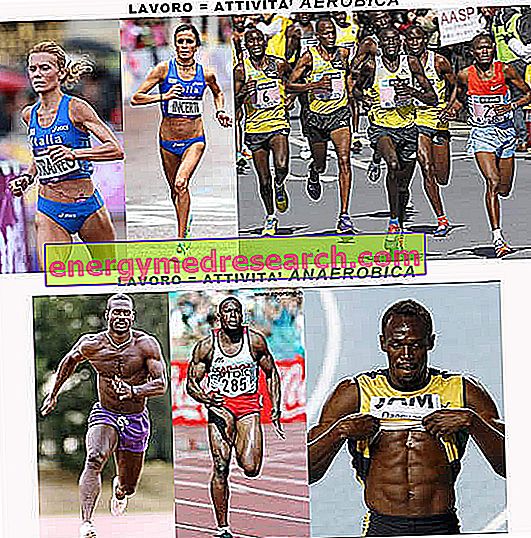Edited by Marino Macchio
WHEREAS, if any PHYSICAL ACTIVITY, if well planned, benefits our physical, but also psychic state, there is no doubt that between AEROBIC work and ANAEROBIC work there is a distinct and distinct difference, the word itself says it ...
Without entering into scientific or pseudoscientific explanations and details, let us try to see the differences in a very simple and OBJECTIVE way, but also the different results on their own PHYSICAL (aesthetic aspect), which will produce the practice of one or the other ACTIVITY.
We reiterate in a CATEGORICA way that regardless of the physical activity practiced, the benefits of a well calibrated job will be innumerable; let's see some of them:
General benefits
- STRESS - Restoring the psychophysical balance compromised by often stressful rhythms of life.
- PSYCHOLOGICAL - Safe increase in: self-esteem, motivation and will, with certain benefits both at work and in private life.
- ENDOCRINE - Hormonal imbalances can cause numerous health problems, motor activity helps to regulate hormonal activity.
- GREASE - Decrease in fat mass and increase in lean mass; an improvement in body composition ensues.
Benefits CARDIO-CIRCULATORY SYSTEM
- HEART - Improves functionality, improves trophism.
- PRESSURE - Improvement of pressure parameters.
- LUNGS - Improvement of the elasticity and functionality of the pulmonary alveoli, with an increase in the elimination of elements that are harmful to health.
- CELLULITE - Reduces water retention problems.
- CHOLESTEROL - Best ratio between LDL (will decrease) and HDL (will increase).
- DIABETES - Helps fight metabolic disorders.
- CAPILLARIES - The capillarization process will be stimulated, consequently there will be an increase in the blood supply to the tissues (muscles, skin, etc.).
Benefits SKELETAL SYSTEM, JOINTS
- ARTHROSIS - Contrasts arthrosis processes
- OSTEOPOROSIS - It contributes to a correct bone metabolism and counteracts the osteoporotic process.
- PARAMORPHISMS - Allows you to check or reduce possible postural defects
Benefits MUSCULAR SYSTEM
- STRENGTH and RESISTANCE - Increase
- ELASTICITY - Improves muscle elasticity (injury prevention).
Aerobic and anaerobic activities
Definition of Aerobic Activity
In motor sciences, an aerobic exercise is a gymnastic-conditional activity in which oxygen becomes a decisive part of the ATP resynthesis process.
Metabolic processes involved: Aerobic glycolysis; β-oxidation; Krebs cycle; Oxidative phosphorylation; Electron transport chain.
Definition of Anaerobic Activity
In motor sciences, a conditional gymnastic exercise is defined anaerobic when ATP resynthesis occurs in the absence of oxygen.
Metabolic processes involved: anaerobic glycolysis; Cycle of Choirs.
What is ATP?
ATP (Adenosin tri-phosphate) is the energy molecule necessary for muscular activity.As we have seen, the difference between the two ACTIVITIES consists in the different "use" of oxygen to produce ATP:
- Aerobic work = production of ATP in the presence of oxygen
- Anaerobic work = ATP production in the absence / lack of oxygen.
Repercussions on body appearance
We come then to broadly focus on the aspect that the two subjects practicing the aforementioned activities will have.

Objectively, the difference between those who practice the two types of physical work at high levels is also visible to a person who is not involved in the work and who does not practice any physical activity, therefore - even without taking a striking example as a Body Builder, the Bodybuilder, but also Pesista to understand each other (both emblematic examples of ANAEROBIC WORK) - everyone can notice the structural differences that exist between the subjects mentioned above and eg. a marathon runner; even a child could tell them apart.
Then, excluding Body Builder, Bodybuilders, who practices Muscle Development and Weightlifters, let's examine the two activities taking as an example two OLYMPIC Sports:
Marathon race, and Corsa Veloce I CENTOMETRI .
- Aerobic activity ( low intensity and long duration activity) : The marathon runner - Slender physicist with linear forms, extremely contained physiological forms, with very little GREASE mass but also with very little MASSA SAGE, hypotonic muscularly compared to and not only to the centometrist;
- Anaerobic activity (power activity: in a short period of time one undergoes an intense effort): The centometrist - Very tonic physicist, broad shoulders, pronounced pectoral muscles, narrow waist, sculpted abdominals, quadriceps and hypertonic calves, not to mention hypertrophied, and finally, very important parameter, the low percentage of total body fat. Most likely the centometrist will have a low percentage of body fat, lower than the marathon runner, simply due to the fact of the greater muscle mass.
It is therefore clear that the two athletes will support two totally different workouts, as well as clearly a different diet.
The substantial difference is that the centometrist in training and in his overall preparation will also include the important use of free weights and / or isotonic machines, while the marathon runner will limit himself mainly to running ...
NB The one hundred meter race is considered an ANAEROBIC sport, since it is a power activity (in a short period of time, an intense effort is made). Suffice it to say that in the 9-10 seconds needed to complete the race, the athletes travel the 100 m breathing once or even cover them completely in apnea ...
In conclusion, if we want to increase the "muscle tone" or even increase the lean mass there is no doubt that the most suitable physical activity is the ANAEROBIC one, better if practiced in gyms equipped with free weights and isotonic machines with the supervision of specialised personnel.
MOREOVER:
- Having more lean mass (muscle) translates into greater caloric consumption even at rest (eg when we sleep). Thus, the most toned and most muscular person will certainly risk less to accumulate fat; moreover it will make much less effort to dispose of the excess fat mass;
- There is no doubt that, particularly in women, ONLY ANAEROBIC physical activity with free weights and isotonic machines will contribute dramatically to the increase in "physiological forms": wider shoulders, narrow waist, round buttocks, full and toned quadriceps .
It should be pointed out, however, that in subjects with short or endomorphic somatotype, this aspect could make the body figure even more "stocky"; therefore, it will be necessary to carefully evaluate the training protocol, favoring the intensity of work with low loads.
To conclude, the "aerobic" sports activity will certainly be important and useful to improve the cardiovascular system and the cardiopulmonary system, but also to complete the final results by helping to increase the oxidative metabolism of fat (raising the basal metabolism). It takes about 25 minutes for 2-3 times a week, possibly at the end of the "anaerobic" training session.
Curiosity
Did you know that the weight gain of 1.5 kg of lean mass, or MUSCOLO,
DETERMINE on average:
- a) The 7% increase in basal metabolism, so you will consume more calories even when you sleep ...
b) In performing sports, your calorie consumption will increase by 15% ...
We deduce that: + muscle + caloric consumption = Decrease in body fat



